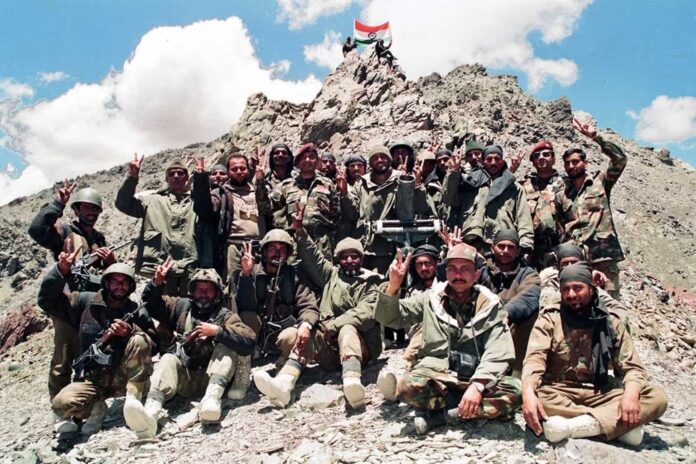India celebrates Kargil Vijay Diwas (Kargil Victory Day) today on 26 July 2024 honouring the legacy and sacrifices of our brave soldiers 25 years ago. This day is a solemn reminder for all Indians about the cost of international peace and the value of national strength. As the nation commemorates Kargil war, the editorial team at IAAN Express brings this special detailed military account feature on what happened in Kargil those many years ago, in a war that redefined who we are today.
Indo-Pak Peace before the War
In August 1947, with the end of British rule, two new nations, India and Pakistan were born in the Indian subcontinent. Ever since, as a legacy of partition, the two nations have been involved in a violent territorial dispute.
In 1966, after the wars of 1947-48, and 1965, the Tashkent Agreement was signed by the Indian Prime Minister Lal Bahadur Shastri and Pakistan’s President General Ayub Khan. According to the clauses of the agreement, the parties agreed to withdraw all armed forces to positions held before 05 August 1965; to restore diplomatic relations; and to discuss economic, refugee, and other questions.
After a brief relief, in 1971, the influx of refugees into the Indian territory during EastPakistan’s (now Bangladesh) struggle for freedom, forced India to intervene resulting in an all out war between India and Pakistan. The war started on 03 December 1971 and lasted for fourteen days. The outcome of the war was the formation of a new nation, Bangladesh. On 02 July 1972, in order to resolve the border tension and prevent further violence, Indian Prime Minister Mrs Indira Gandhi and Pakistan’s Prime Minister Mr Zulfikar Ali Bhutto signed the Simla Agreement.
As per the clauses of the agreement, Indian and Pakistani forces were to be withdrawn to their respective sides of the border. In Jammu and Kashmir, the Line of Control (LC) resulting from the cease-fire was formally established. Both states agreed to not alter the LC unilaterally, irrespective of mutual differences and legal interpretations. Further, both India and Pakistan agreed to refrain from the use of military power and withdraw their forces along the LoC.
In May 1998, both India and Pakistan declared themselves as nuclear powers, escalating the security concerns of both the nations. The possibility of a nuclear exchange between the two countries was reduced by signing of the Lahore Declaration in 1999 by the Prime Minister of India, Shri Atal Behari Vajpayee and the Prime Minister of Pakistan, Muhammad Nawaz Sharif in Lahore, Pakistan on 21 February 1999.
The Lahore Declaration reaffirmed India and Pakistan’s commitment to peaceful resolution of their long standing border dispute over the state of Jammu and Kashmir. Each side pledged to take immediate steps for reducing the risk of accidental or unauthorized use of nuclear weapons and discuss concepts and doctrines with a view to elaborating measures for confidence building in the nuclear and conventional fields, aimed at prevention of conflict.
But soon the clauses of Simla Agreement and commitments to peaceful conflict resolution were breached by Pakistan Army.
Kargil: Infiltration across the Line of Control
In 1999, shortly after the signing of the Lahore Declaration, Pakistani forces disguised as Kashmiri terrorists infiltrated on the Indian side of the LC and took over the Indian Army’s winter vacated posts, as part of an operation, code-named “Operation Badr.” The aim was to cut the link between Kashmir and Ladakh, to isolate Indian Army troops on the Siachen Glacier, and force India to negotiate a settlement of the Kashmir dispute.
As most of the infiltration took place in the Indian district of Kargil, the war came to be known as the Kargil War. It was fought in high altitude mountains, with jagged, near vertical hill faces, which posed both tactical and logistical problems. It is the only instance of a conventional war among two nuclear armed countries. The area that witnessed the infiltration and fighting was approximately 160-kilometre-long stretch of ridges overlooking the only road linking Srinagar and Leh. The military posts on the ridges above the highway were generally around 5,000m (16,000 ft) high, with a few as high as 5,485m (18,000 ft). The operational area was divided in two sectors, viz. Kargil and Batalik Sectors.
The Kargil war had three phases:
First: Pakistani infiltration across LoC and occupation of posts to bring down artillery fire on the main highway (NH 1A) and Kargil town.
Second: Indian Army’s discovery of the infiltration and mobilising forces to respond to it.
Third: major attacks by Indian forces resulting in recapture of most of the posts and withdrawal of residual Pakistani troops back across the LoC.
Once India mobilised, the Indian Army supported by the Indian Air Force, regained control of the hills overlooking the highway and then commenced driving the invading force back across the LoC.
Conduct of Military Operations
On 03 May 1999, local people first reported of the presence of unidentified personnel at an army unit at Banju Headquarters of Kargil sector. Reconnaissance patrols were expeditiously despatched to investigate the presence of infiltrators. Over the next few days, extensive patrolling and aerial reconnaissance were conducted.
The magnitude of Pakistan’s invasion and preparation was quickly revealed, and plan was prepared to evict Pakistani troops from the Indian side of the LoC. This was to be done as soon as possible and with least possible casualties. To avert escalation of the conflict, the Indian government stipulated that the LoC should not be crossed by the Indian armed forces.
It was soon realised that the operations to recapture the ridgelines back from Pakistani regulars would be extremely difficult. Infantry assaults would have to be undertaken at very high altitudes while facing heavy enemy fire from multiple directions. It is a well-known maxim that the mountains favour the defenders. Attacking uphill puts an attacker at a significant disadvantage.
It was appreciated at the Army Headquarters, that maximum available airpower would need to be requisitioned before infantry battalions could launch physical assaults to regain each position. Formation commanders emphasised the necessity of destroying the enemy’s prepared positions through coordinated preparatory bombardment to reduce combat potential of the posts and break the enemy’s will to fight.
It was also appreciated that the ground strikes from the fighter aircrafts of the Indian Air Force (IAF) would be necessary to strike at the enemy positions, particularly those that were not directly visible to ground observers. Cabinet approval for the air strikes against the enemy positions within own territory was sought and obtained. The first air-to-ground strikes by fighter aircraft of the IAF were launched on 26 May 1999 as a part of Operation Safed Sagar.
Tri Service Joint Operations
All three Services came together to launch the tri-service joint plan. The Indian military leadership included the use of all the elements of military power in the joint plan. It was decided to use the Indian Air Force to target the entrenched positions of the infiltrators, on the high ridges, in the region and the artillery, to not allow the intruders any rest. Meanwhile the Navy, unencumbered by the constraint of not crossing the LoC deployed proactively in full strength to signal that any expansion of conflict would result in the full might of our military being brought to bear upon Pakistan.
The plan was a departure from the strategic restraint that India has generally shown against the sub-conventional provocations by Pakistan.
It was the Western Air Command that was involved in the Operation Safed Sagar during the Kargil War. As the magnitude of the armed intrusion became apparent and a clear picture emerged, the IAF was pressed into action. Additional fighters and armed Mi-17 aircraft moved into Srinagar and Awantipur airfields. IAF operations in the Kargil Sector of Northern Kashmir were conducted for a period of seven weeks, from 26 May 1999 when the first air strikes were launched till 12 July 1999 when these were suspended to allow Pakistani forces to withdraw Northwards to their side of the LoC. Operating with restrictions of staying clear of LoC and engaging unconventional targets such as tents and sangars at altitudes of 4500-5000 mtrs, a number of fighter Sqns of WAC were deployed. Helicopters carried out some 925 hours of flying. They evacuated 441 casualties and airlifted into position a large number of men required immediately at different Sectors.
Although the Air Force offensive operation began on 26 May 1999, after the Cabinet Committee of Security’s approval, the IAF had already commenced a large scale airlift of troops, ammunition and stores into the sector as the presence on the ground had traditionally been thinned out during winters.
It also commenced aerial reconnaissance-and-strike familiarisation. The rapid mobilisation ensured that the IAF was ready for undertaking wide ranging full scale military operations by the morning of May 15.
Overall, the deployment of the Indian Air Force clearly shortened the duration of the War. The strikes conducted by the Indian Air Force during the crucial phase of army operations were decisive, incurring fewer losses, and in a shorter duration, making ways for smooth conduct of ground based operations by the Indian Army. Most importantly, the Indian Air Force achieved its primary objective of degrading the enemy’s offensive capabilities, softening its defence and denying essential supplies.
On the other hand, Indian Navy conducted its operation on the Naval front with the largest ever deployment of combatant ships in the Arabian Sea. The Indian Navy, by virtue of its capability, strategic positioning and robust presence in the Indian Ocean Region (IOR) was able to deter any untoward activities by the Pakistan Naval Force.
Indian Navy adopted two pronged approach to tackle Pakistan Navy in the Indian Ocean – First, it wanted to ensure the that Indian assets are protected and remain safe in the Indian Ocean region. Secondly, it wanted to pre-empt any escalatory measures by the Pakistani Navy.
The deployment was also meant to send a message to the Pakistan authorities that the blockade of the Pakistan coast was imminent if the Kargil conflict is escalated to a wider dimension. It through strategic deployment of combat ready ships of units of the Eastern Fleet joining the Western Fleet clearly demonstrated its intent and will to combat any attempt by Pakistan to think of expanding the battle from the limited Kargil sector. Indian Navy experience during Operation Vijay (Kargil Operations) bears testimony to the utility of strong maritime forces in dissuasion and control of escalation. Indian Navy’s posture in the North Arabian Sea, contributed significantly to the early achievement of India’s operational goals and, more importantly, in limiting the scope of the conflict.
Operation Vijay
The military strategy of Operation Vijay was to contain-evict-deny. The aim was to contain and limit the intrusion up to the identified areas, undertake operations to evict Pakistan army from the Indian side of the LC and finally, to enhance surveillance, patrolling, and deployment as per the need, to ensure that the Pakistan army was denied the opportunity to launch another assault.
In the army’s plan, priority was given to the eviction of the infiltrators from the ridgelines which dominated the Srinagar-Leh Highway, such as the Tololing complex in the Dras sub-sector.
Next in order of priority was the Batalik-Turtok Sub-Sector as it provided access to the Ladakh-Siachen region. Relatively lower priority was accorded to the Mushkoh Valley and Kaksar sub-sectors as the intrusion in these areas had lesser tactical significance.
3 Infantry Division was responsible for the operations in the area. In addition, 8 Mountain Division, then engaged in counter-insurgency operations in the Kashmir Valley, was inducted into the Kargil Sector. With the deployment of an additional formation, 3 Infantry Division was assigned the responsibility of operations in the Batalik and Kaksar Sub-Sectors. The responsibility for the conduct of operations in the Dras and Mushko Valley Sub-Sector was assigned to 8 Mountain Division. Additional infantry battalions, artillery Regiments and Engineer units were inducted in these Sectors on a required basis.
Artillery Regiments were also inducted from other parts of India. The aim was to clearly achieve a preponderance of firepower. Logistics plan was fine-tuned to sustain the additional forces in the difficult terrain of Kargil Sector. Fortuitously, Zoji La pass opened in the early May 1999 (it normally opens by mid-June every year) and the additional induction of combat forces and logistic units became possible when it was most required. Specialised equipment and extreme climate cold clothing necessary for fighting at such high altitudes were rushed in from various Sectors.
While additional troops were building up and acclimatisation was underway, attempts were made to get around the intruders’ positions and cut off their supply lines. These efforts were only partially successful due to the lie of the ground and the dominating observation that the intruders enjoyed. Along with regular troops, Special Forces troops were also employed for such tasks.
The artillery utilised this time interlude to prepare main, secondary and alternative gun positions, to carryout survey and to register targets. Plans for high-intensity fire assault were drawn up and coordinated in consultation with infantry battalion commanders and brigade commanders. Counter bombardment (CB) and Counter Mortar (CM) plans were made and fine-tuned. Maximum use was made of air photographs to accurately locate enemy gun positions and other key targets deep inside enemy territory. These were then fired upon and attempts were made to carry out damage assessment through aerial reconnaissance.
Meanwhile, the troops of Pakistan’s Northern Light Infantry holding defence on the Indian side of LC were allowed no rest and were kept on the edge by accurate firing and skilfully evolved harassing fire (HF) fire plans.
Over the course of three months, Indian Army recaptured all the Indian posts that were covertly occupied by the Pakistan Army.
Timeline of the Kargil War
May 1999
3 May 1999 – Shepherds report Intruders sighted for the first time at Banju Headquarters.
5 May 1999 – Patrol sent out to examine the suspicion of intrusion, the War commences.
6 May 1999 – NH 1A opened to traffic.
16 May 1999 – 56 Mountain Brigade takes over Dras- Mushkoh Sector.
18 May 1999 – The Capture of Points 4295 and 4460
21 May 1999 – 8 SIKH start siege of Tiger Hill
23 May 1999 – Chief of Army Staff (COAS) visit Kargil sector and priorities for the days and doctrine for the conduct of operation were laid.
24 May 1999 – 79 Mountain Brigade take over Mushkoh Sub-Sector.
25 May – Entire Western Fleet had sailed from Mumbai to the North Arabian Sea as a precautionary deployment.
26 May 1999 – Indian Air Force begins Air Operations in support of 15 Corps
June 1999
1 June 1999 – Headquarters 8 Mountain Division completes take over. Start of the military build-up.
3 June 1999 – 8 Division assumes responsibility for part of the Kargil Theatre west of Thasgam.
12 June 1999 – (a) Ongoing talks between Indian and Pakistani Foreign Ministers deadlocked. (b) 50 (I) Parachute Brigade arrives in Gumri from Army reserve and comes under command of 8 Divisions.
13 June 1999 – 56 Brigade takes Tololing and Point 4590.
14 June 1999 – Indian Forces take the ‘Hump’.
15 June 1999 – United States President Bill Clinton urges Prime Minister Nawaz Sharif to withdraw.
20 June 1999 – 56 Brigade takes Point 5140.
23 June 1999 – (a) General Zinni, Commanding General United States Central Command visits Pakistan to urge Nawaz Sharif to withdraw. (b) The G-8 Nations call for an end to the intrusion.
26 June 1999 – 192 Mountain Brigade arrives in Dras from the valley and comes under command of 8 Mountain Division.
28 June 1999 – 56 Brigade takes Point 4700.
29 June 1999 – 56 Brigade captures area ‘Black Rock’, ‘Three Pimple’ and ‘Knoll’.
30 June 1999 – India’s Amphibious Brigade started moving westwards from Port Blair to Goa
July 1999
1 July 1999 – 70 Brigade captures Point 5000.
3 July 1999 – (a) 70 Brigade captures Point 5287. (b) End of 8 SIKH siege of Tiger Hill.
4 July 1999 – (a) 192 Brigade captures Tiger Hill (b) Nawaz Sharif, in Washington, urged by Clinton to start talking with India.
5 July 1999 – 79 Brigade takes Point 4875 complex. By now, virtually the whole of Mushkoh and Dras were clear of enemy.
12 July 1999 – IAF operation suspended to allow Pakistani forces to withdraw to their side of the LoC.
12 -18 July 1999 – Ceasefire to allow safe withdrawal of Pakistan Troops across LC. (They reneged and the war was resumed)
24 July 1999 – 192 Brigade takes Zulu Spur Complex
26 July 1999 – Official Ending of the Kargil War
Kargil was India’s first televised war, with live scenes from the conflict streaming into the homes of millions of Indians. It reshaped Indian strategic thought vis a vis Pakistan and redefined an entire generation and the nation for decades to come.










